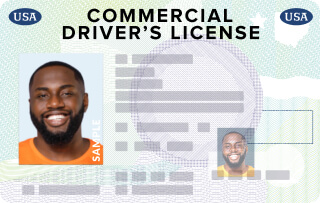- Updated for March 2025
- Based on 2025 CT commercial driver's license manual
Free Connecticut CDL Combination Practice Test 2025
We bet we know why you’re here: You need to pass the official Combination Vehicles knowledge test on the theory of operating combination vehicles. You’ve been studying the official Connecticut Commercial Driver License Manual (Connecticut CDL Handbook 2025), especially Chapter 6 (Combination Vehicles), because you know the knowledge test is based on it. But after you looked at this official study guide, you felt you could use some more help to be sure of passing the knowledge test. Great! That’s just what we do. We’ve helped thousands of aspiring drivers pass their knowledge tests, and we can help you too.
This free Connecticut CDL Combination practice test is also based on the official manual and is up to date as of March, 2025. Practicing with it will reinforce your knowledge and identify topics you need to study further. Each of the 25 practice questions comes with a helpful hint and an explanation of the correct answer. The practice questions and answers on this test will assess your knowledge of such topics as safe driving techniques, combination braking systems, and coupling and uncoupling. We have other Combination practice tests too. Keep practicing with them until you’re ready to take the official Combination Vehicles knowledge test.
Be advised that virtually all large semi-trucks and tractor-trailers are equipped with air brakes. Your Commercial Driver’s License (CDL) will prohibit you from operating vehicles equipped with air brakes until you pass the official Air Brakes knowledge test. Don’t worry; we have a number of Air Brakes practice tests you can use to prepare for that knowledge test as well.
With your Class A CDL in hand, you should be able to find plenty of work in Connecticut as a semi-truck driver. The agricultural sector depends on truckers to transport its products. Manufacturing, largely in defense and aerospace, is the state’s third-largest economic sector after finance, insurance, and real estate. These high-tech firms depend on truckers to deliver equipment and materials to them as well as transport their products.
The most important trucking route in Connecticut is Interstate 95, which runs along the coast between New York City and Rhode Island but is notorious for traffic jams during rush hours. Other important commercial routes include Interstate 84, which connects Hartford with Massachusetts and New York State; and Interstate 91, which connects New Haven to Hartford, continues into Massachusetts and Vermont, and then continues into Quebec as Autoroute 55.
- Perfect for first-time and renewal CDL/CLP applicants, and those adding endorsements
- Triple-checked for accuracy
What you need to know

What to expect on the actual CT DMV exam
questions
correct answers to pass
passing score
List of questions (classic view)
- After you lock the kingpin into the fifth wheel, how should you check the connection?
- After you connect the air lines but before you back under the trailer, you should
- Which statement best illustrates the "crack-the-whip" effect?
- When you inspect the landing gear after uncoupling the trailer, where should the tractor be?
- What is the safest way to turn right from a two-way road?
- To drive a triple combination vehicle, you must have
- To prevent a rollover, cargo should be
- Combination vehicles take longer to stop when they are empty than when they are fully loaded, because
- If your vehicle gets stuck on a railroad track, you should
- Low-slung vehicles can be risky at railroad crossings because
- On a double or triple vehicle, which wheels offtrack the most?
- When you're pulling doubles or triples, the shut-off valves should always be
- On a trailer, where is the yellow antilock brake (ABS) malfunction lamp located?
- Even before antilock braking systems (ABS) were required, some vehicles already had them. How can you check if your vehicle has ABS?
- An antilock braking system (ABS) is useful
- After coupling, make sure that the air lines are not crossed. How should you do this?
- During uncoupling, you should disconnect the electrical cable and
- Before you start to uncouple, you must
- You can confirm that air is going to all brakes in your trailers by
- To uncouple a loaded trailer, after the landing gear has made firm contact with the ground, you should
- If the trailer has antilock brakes (ABS) but the tractor doesn't,
- To test the tractor protection valve, charge the trailer air brake system, turn off the engine, and
- If your test of the tractor protection valve is successful,
- The tractor protection valve is designed to close automatically if the air pressure falls into the pressure range specified by the manufacturer, typically
- As part of your vehicle inspection test, if your vehicle is equipped with air brakes and has a trailer, you will inspect the air connections between the truck or tractor and the trailer. Make sure that the ________ are locked in place and free of damage or air leaks.
- Alabama: Test 1 / Test 2
- Alaska: Test 1 / Test 2
- Arizona: Test 1 / Test 2
- Arkansas: Test 1 / Test 2
- California: Test 1 / Test 2
- Colorado: Test 1 / Test 2
- Connecticut: Test 1 / Test 2
- Delaware: Test 1 / Test 2
- District of Columbia: Test 1 / Test 2
- Florida: Test 1 / Test 2
- Georgia: Test 1 / Test 2
- Hawaii: Test 1 / Test 2
- Idaho: Test 1 / Test 2
- Illinois: Test 1 / Test 2
- Indiana: Test 1 / Test 2
- Iowa: Test 1 / Test 2
- Kansas: Test 1 / Test 2
- Kentucky: Test 1 / Test 2
- Louisiana: Test 1 / Test 2
- Maine: Test 1 / Test 2
- Maryland: Test 1 / Test 2
- Massachusetts: Test 1 / Test 2
- Michigan: Test 1 / Test 2
- Minnesota: Test 1 / Test 2
- Mississippi: Test 1 / Test 2
- Missouri: Test 1 / Test 2
- Montana: Test 1 / Test 2
- Nebraska: Test 1 / Test 2
- Nevada: Test 1 / Test 2
- New Hampshire: Test 1 / Test 2
- New Jersey: Test 1 / Test 2
- New Mexico: Test 1 / Test 2
- New York: Test 1 / Test 2
- North Carolina: Test 1 / Test 2
- North Dakota: Test 1 / Test 2
- Ohio: Test 1 / Test 2
- Oklahoma: Test 1 / Test 2
- Oregon: Test 1 / Test 2
- Pennsylvania: Test 1 / Test 2
- Rhode Island: Test 1 / Test 2
- South Carolina: Test 1 / Test 2
- South Dakota: Test 1 / Test 2
- Tennessee: Test 1 / Test 2
- Texas: Test 1 / Test 2
- Utah: Test 1 / Test 2
- Vermont: Test 1 / Test 2
- Virginia: Test 1 / Test 2
- Washington: Test 1 / Test 2
- West Virginia: Test 1 / Test 2
- Wisconsin: Test 1 / Test 2
- Wyoming: Test 1 / Test 2
Your go-to, trusted source
Experience the Driving-Tests differenceOur commitment to accuracy and quality in our practice tests
Explore our rigorous, multi-tiered verification process that ensures each question mirrors the official manual for unparalleled accuracy.

At Driving-Tests.org, we understand the importance of reliable and accurate practice tests to help you prepare for your DMV exam. That's why we've developed a meticulous process to create and continually update our practice questions, ensuring they reflect the most current driving laws and regulations.
Here's an inside look at how we maintain the highest quality in our practice tests.
Content Creation and Verification Process
- Alignment with Official Manuals:
Every question we develop is based on the most recent version of each state's official driving manual. Our team regularly monitors each state DMV's website for the latest updates to ensure our practice tests are always aligned with the most current information. - Community Feedback Integration:
We leverage feedback from our vast community of users to understand which topics are most frequently tested. This helps us focus on the areas that are most relevant and beneficial for your preparation. - Expert Content Creation:
Our in-house editor, Steven, who has extensive experience in driver education, crafts each question with precision. He conducts a thorough review of each question against the official manuals to ensure accuracy. - Rigorous Review Process:
Once Steven has finalized a set of questions, our team conducts a joint review session. This second level of scrutiny involves content accuracy, proofreading, and fact-checking to eliminate any errors. - User Feedback Mechanism:
After a question goes live on our site, we keep the lines of communication open. Each question features a feedback button, inviting users to report any issues or errors. This continuous feedback loop allows us to address and rectify any concerns promptly. - Responsive Updates:
In line with our commitment to accuracy, we quickly update our practice questions to reflect any changes in the DMV manuals. Additionally, we update the free electronic copy of the state's driver's license manuals on our site, typically within a few days after the DMV publishes them.
Our thorough quality control process ensures that you have access to practice tests that are as accurate and up-to-date as possible. We believe in the power of well-prepared drivers and are dedicated to providing you with the best study tools to help you succeed on your DMV exam.
Pass the First Time – Guaranteed
You’re moments away from your results.
Before you view them, see how 1.15 million drivers used Premium to pass faster.
Real Exam-Like Connecticut Questions
Get all exam-like questions seen on the real test.
99.06% Pass Rate vs. 49% Average
Most Premium users pass on their first try.
Money-Back Guarantee
We stand behind you until you pass.




